This past year the second supplement for the Pre-dread period was releases "Rise of the Battleship II" which includes data for the Spansih American war ships as well as many other fleets from around the world. As a result of these rules My interest has really peaked in this time period and I have done much reading on the subject. It is a very interesting period in world history when batttleships were making their presence known on the world stage and battleship diplomancy was becoming the symbol of a nations military strenght.
Below is a history of the Battle of Santiago De Cuba along with pictures of my 1/2400 scale fleets that I use to game this and other famous engagements along with many "what if" ahistorical battles. In school I was taught that the Spanish American war was were America made a debut on the world stage defeating a world power. Going back now and reading what what not in the text books it is clear that the United States was already a world power and that the outcome of that war was never in question from a military standpoint.
The historical text below comes from the wikepedia entry on the battle.
http://en.wikipedia.org/wiki/Battle_of_Santiago_de_Cuba
Battle of Santiago de Cuba
The Spanish realized that the war would be decided by the campaign in Cuba. Even before the opening of hostilities, Admiral Pascual Cervera y Topete had been dispatched from Spain with the ultimate destination of Cuba. At best, the Spanish hoped to show the flag in their largest remaining New World colony; at worst, they hoped to have a force prepared to meet the powerful U.S. Navy.
 |
| Admiral Pascual Cervera |
However, it is evident from the records of the time and from Cervera's own writings that the Spanish admiral had the feeling that he was sailing to his doom. The breech mechanisms in many of the Spanish guns were dangerously faulty, causing jams and other mishaps. Many of the ships' boilers were in need of repair; several ships, including the armored cruiser Vizcaya, desperately needed bottom-cleaning as they were suffering from extra drag due to fouling. Worse yet, many of the gun crews were out of practice, having little experience with firing live rounds due to naval budget cuts since the Rif War in 1893-1894 and funding priority given to the Spanish Army. The most well-protected ship in Cervera's fleet, the second-generation armored cruiser Cristobal Colon, had not even had her main battery installed and carried wooden dummy guns instead.
Spanish Caribbean Squadron - Admiral Pascual Cervera


Early in the year, Cervera had attempted to convince the Ministerio de Marina, a bureaucratic body responsible for governing Spain's admiralty, that the best strategy lay in resisting the Americans near the Canary Islands. Here, the fleet could be repainted, recoaled, and overhauled. It would then lie within range of the vast reserves of ammunition established in Spain and the firepower of the "Home Squadron". Cervera argued that he could then meet the U.S. fleet and destroy it. This strategy was endorsed by every officer under his command and many in the "Home Squadron", but was rejected by the Admiralty. Cervera's own misgivings reveal the seriousness of the situation faced:
•Armored Cruiser Infanta Maria Teresa (flagship)
•Armored Cruiser Almirante Oquendo
•Armored Cruiser Vizcaya

•Armored Cruiser Cristobal Colon
•Torpedo Boat Destroyer Pluton
•Torpedo Boat Destroyer Furor

Early in the year, Cervera had attempted to convince the Ministerio de Marina, a bureaucratic body responsible for governing Spain's admiralty, that the best strategy lay in resisting the Americans near the Canary Islands. Here, the fleet could be repainted, recoaled, and overhauled. It would then lie within range of the vast reserves of ammunition established in Spain and the firepower of the "Home Squadron". Cervera argued that he could then meet the U.S. fleet and destroy it. This strategy was endorsed by every officer under his command and many in the "Home Squadron", but was rejected by the Admiralty. Cervera's own misgivings reveal the seriousness of the situation faced:
- It is impossible for me to give you an idea of the surprise and consternation experienced by all on the receipt of the order to sail. Indeed, that surprise is well justified, for nothing can be expected of this expedition except the total destruction of the fleet or its hasty and demoralized return.
 |
| Cristobal Colon (left) and Vizcaya |
Cervera managed to evade the U.S. fleet for several weeks, confounding his American counterparts and managing to re-coal in the process. Meanwhile Villaamil, who was in disagreement with both the Spanish Government's shaky war direction and Cervera's rather passive strategy, advocated trying to offset the superiority of the American forces by scattering the fleet and taking the initiative through quick and dispersed actions; he even volunteered to lead a diversionary attack to New York with his destroyers, but his proposals were not accepted.
Finally, on 29 May, after several misadventures, Cristóbal Colón was spotted in the harbor at Santiago de Cuba by an American squadron.
American Fleet
 |
| Rear Admiral William T. Sampson |
With the exception of Commodore George Dewey's squadron in the Pacific, nearly every warship in the United States Navy was near or on its way to Cuba. Only a handful of reactivated American Civil War era monitors and cutters of the United States Revenue Cutter Service remained to defend the U.S. coastline.
The primary elements of the U.S. force in Cuban waters were divided between two men: Rear Admiral William T. Sampson of the North Atlantic Squadron and Commodore Winfield Scott Schley and the "Flying Squadron".
On the morning of 29 May, Cervera's squadron was sighted inside the safety of Santiago Bay, Cuba, by elements of the "Flying Squadron". On 31 May, Schley was joined by Sampson, who took command of the situation and instructed a general blockade.
US North Atlantic Squadron - Rear Admiral William T. Sampson
•Armored Cruiser USS New York (flagship)
•Battleship USS Iowa
•Battleship USS Indiana
•Battleship USS Oregon
•Armed Yacht Gloucester
US "Flying Squadron" - Commodore Winfield Scott Schley
•Armored Cruiser USS Brooklyn (flagship)
•Battleship USS Texas
•Battleship USS Massachusetts
•Armed Yacht USS Vixen
Stand-off in Santiago HarborSo long as Cervera remained within Santiago Harbor, his fleet was relatively safe. The guns of the city were quite sufficient to make up for deficiencies in his own, and the area was well defended with sea mines, torpedoes and other obstructions. Nevertheless, Cervera was terribly outmatched. Though his ships were modern, they were too few, and their technical problems compounded his worries. The failure of Cuba's governor to assist with the repairs of the vessels in Cervera's squadron made the situation all the more desperate.
For more than a month, the two fleets faced off, with only a few inconclusive skirmishes resulting. For his part, Cervera was content to wait, hoping for bad weather to scatter the Americans so that he could make a run to a position more favorable for engaging the enemy. However, U.S. land forces began to drive on Santiago de Cuba, and by the end of June 1898, Cervera found himself unable to remain safely in the harbor. He would have to break out immediately if the fleet was to be saved.
The breakout was planned for 09:00 on Sunday, 3 July. This seemed the most logical time: the Americans would be at religious services, and waiting until night would only serve to make the escape that much more treacherous. By noon on Saturday, 2 July, the fleet had a full head of steam and had fallen into position for the breakout.
At about 08:45, just as his ships had slipped their moorings, Admiral Sampson and two ships of his command, his flagship, the armored cruiser USS New York, and the torpedo boat USS Ericsson had left their positions for a trip to Siboney and a meeting with Major General William Shafter of the U.S. Army. This opened a gap in the western portion of the American blockade line, leaving a window for Cervera.
Sampson's New York was one of only two ships in the squadron fast enough to catch Cervera if he managed to break through the blockade. Further, the battleship USS Massachusetts had left that morning to coal. With the departure of Admiral Sampson, who had signaled "Disregard movements of flagship," immediate command devolved to Commodore Schley in armored cruiser USS Brooklyn, which now became the de facto flagship of the U.S. blockade.
Thus, the American blockade formation that morning consisted of Schley's Brooklyn, followed by the battleships USS Texas, Oregon, Iowa and Indiana and auxiliary cruisers USS Vixen and Gloucester.
At 09:35, the navigator of Brooklyn sighted a plume of smoke coming from the mouth of the port. He anxiously signaled the rest of the fleet:
The Enemy is coming out!
The Spanish ships began their race from the mouth of Santiago Bay at about 09:45, traveling in a rough line ahead formation. In the lead was Cervera's flagship, the armored cruiser Infanta Maria Teresa, followed by the armored cruisers Vizcaya, Cristóbal Colón, and Almirante Oquendo, and finally the torpedo-boat destroyers Furor and Pluton. The four cruisers immediately cut in a southwest direction, attempting to break into the open sea before the U.S. blockading force could respond.
The battle commenced almost immediately, the first shots being fired by Cervera's Infanta Maria Teresa as she strove to gain the western gap in the blockade line before Brooklyn could close it. While the Spanish had taken the initiative by beginning the engagement, two factors slowed their escape. The first was the continuing problem experienced in maintaining proper speed by Vizcaya; the second was the poor quality of most of the coal in the Spanish holds. An expected re-supply of high-quality Cardiff coal from Britain had been captured, along with its transport, by the American auxiliary cruiser USS Saint Paul on 25 May.
Upon sighting the emerging Spanish ships, the American blockaders had to turn to the south since they had all been facing towards the harbor entrance. Brooklyn headed nearly straight for Infanta Maria Teresa at first, but when it appeared that she would be surrounded by all four of the Spanish cruisers, Commodore Schley ordered a "retrograde loop" that pulled her away, and then alongside, the line of Spanish ships fleeing southwest. This maneuver has been controversial ever since, because it seemed to threaten Texas with collision and forced her to stop engines for some moments. Texas then swung behind Brooklyn. Oregon, initially to the rear of the action but the fastest ship in the U.S. fleet, soon raced past Indiana, which had an engine problem and could make only 9 kn (10 mph; 17 km/h) at the time of the battle. Iowa had started from a disadvantaged position and was passed by Infanta Maria Teresa but hit her with two 12 in (300 mm) rounds from 2,600 yd (2,400 m) and swung into the chase. As Iowa was passed in turn by Cristóbal Colón, the Spanish ship hit her with two shots from her secondary battery. One of these, struck near the waterline and caused Iowa to slow and she therefore engaged Almirante Oquendo, bringing up the rear of Cervera's four cruisers.
Rather than expose the entirety of his fleet to the American battle line, Cervera had signaled his other ships to continue to the southwest while he attempted to cover their escape, directly engaging Brooklyn, his nearest enemy. Though Brooklyn was hit more than 20 times during the battle, she suffered only two casualties, while her return fire resulted in the deaths of most of Cervera's bridge crew and grave damage to the ship generally. Under this brutal punishment, Infanta Maria Teresa began to burn furiously. Cervera ordered her aground in shallows along the Cuban coast, by which time she was completely wrecked and aflame. Admiral Cervera survived and was rescued, picked up near Punta Cabrera by the crew of Gloucester.
The rest of the Spanish fleet continued its race for the open sea. Almirante Oquendo was hit repeatedly by Iowa and driven out of the battle by the premature detonation of a shell stuck in a defective breech-block mechanism of an 11 in (280 mm) turret. A boiler explosion finished her, and she was ordered scuttled by her mortally wounded Captain Lazaga. Pluton and Furor made a dash in a direction opposite the rest of the Spanish squadron. At first taken under light fire by Gloucester and then, fatally, by shelling from the battleships Iowa, Indiana, and eventually New York, commanded by Rear Admiral Sampson who had turned his flagship around and was racing to join the fight. Furor was sunk before making the beach, with the lifeless body of her commander Villaamil and several of his sea-fellows; Pluton succeeded in grounding herself but blew up.
 |
| Vizcaya Blows Up |
Within a little more than an hour, five of the six ships of the Spanish Caribbean Squadron had been destroyed or forced aground. Only one vessel, the speedy new armored cruiser Cristóbal Colón, still survived, steaming as fast as she could for the west and freedom. Though modern in every respect and possibly the fastest ship in either fleet, Cristóbal Colón had one serious problem: She had been only recently purchased from Italy, and her main 10 in (250 mm) armament was not yet installed because of a contractural issue with the British firm of Armstrong[disambiguation needed
 ]. She therefore sailed with empty main turrets, albeit retaining her ten 6 in (150 mm) secondary battery. This day, speed was her primary defense.
]. She therefore sailed with empty main turrets, albeit retaining her ten 6 in (150 mm) secondary battery. This day, speed was her primary defense.At her best rate of nearly 20 kn (23 mph; 37 km/h), Cristóbal Colón slowly distanced herself from the pursuing U.S. fleet. Her closest antagonist, USS Brooklyn, had begun the battle with just two of her four engines coupled, because of her long stay on the blockade line and could manage barely 16 kn (18 mph; 30 km/h) while building steam. As Brooklyn helplessly tossed 8 in (200 mm) rounds at the rapidly disappearing Cristóbal Colón, there was only one ship in the U.S. fleet with a chance of maintaining the pursuit. Only the Oregon, now inexorably moving up through the pack, had the speed to overhaul Cristóbal Colón.
At the start of the war, Oregon was anchored in San Francisco Bay. In this age before the Panama Canal, she had taken 67 days to come 15,000 mi (13,000 nmi; 24,000 km) at maximum speed, all the way around South America and through the violent Strait of Magellan, to join the U.S. fleet off Santiago de Cuba. An epic journey in itself, this voyage was now to be capped by a deadly race which no other American warship in the fight could have won.
For 65 minutes, Oregon pursued Cristóbal Colón. Cristóbal Colón had to hug the coast and was unable to turn toward the open sea because Oregon was standing out about 1.5 mi (1.3 nmi; 2.4 km) from Cristóbal Colón's course and would have been able to fatally close the gap had Cristóbal Colón turned to a more southerly course.
Finally, three factors converged to end the chase: First, Cristóbal Colón had run through her supply of high-quality Cardiff coal and was forced to begin using an inferior grade obtained from Spanish reserves in Cuba. Second, a peninsula jutting out from the coastline would soon force her to turn south, across Oregon's path. And third, on the flagship Brooklyn, Commodore Schley signaled Oregon's Captain Charles Clark to open fire. Despite the immense range still separating Oregon and Cristóbal Colón, Oregon's forward turret launched a pair of 13 in (330 mm) shells which bracketed Cristóbal Colón's wake just astern of the ship.
Captain Emilio Diaz Moreu, humanely declining to see his crew killed to no purpose, abruptly turned the undamaged Cristóbal Colón toward the mouth of the Tarquino River and ordered the scuttle valves opened and the colors struck as she grounded. His descending flag marked the end of Spain's naval power in the New World.
As the ships of the U.S. fleet pushed through the carnage, rescuing as many Spanish survivors as possible, an officer was fished out by sailors of Iowa. At first unrecognizable under a bloody bandage and covered in oil and soot, this man proved to be Captain Don Antonio Eulate of Vizcaya. Standing shakily on the deck of Iowa, he thanked his rescuers and gravely presented his sword to Captain Robley Evans, who handed it back as an act of chivalry. Eulate then turned to look out at the burning wreck of his ship and saluted her.
- Adios, Vizcaya!
Aftermath
The battle was the end of any noteworthy Spanish naval presence in the New World.[citation needed] It forced Spain to re-assess its strategy in Cuba and resulted in an ever-tightening blockade of the island. While fighting continued until August, when the Treaty of Paris was signed, all surviving Spanish capital ships were now husbanded to defend their homeland leaving only isolated units of auxiliary vessels to defend the coast. Uncontested U.S. control of the seas around Cuba made resupply of the Spanish garrison impossible and its surrender inevitable.
The U.S. ships at Santiago, for their part, suffered many hits in the battle but very little serious damage. The small armed yacht Vixen was nearly sunk, but casualties on the American side of the affair were remarkably light; only one man was killed, Yeoman George Henry Ellis of Brooklyn. Spanish casualties numbered nearly 500, including Captain Villaamil of Furor, the highest-ranking Spanish officer to lose his life in the battle. All six vessels of the Spanish squadron were lost. The 1,612 Spanish sailors rescued, including Admiral Cervera, were sent to Seavey's Island at the Portsmouth Naval Shipyard in Kittery, Maine, where they were confined at Camp Long from July 11, 1898 until mid-September 1898.
In the aftermath of the battle, General Chambers McKibbin, originally of Chambersburg, Pennsylvania, was selected as Military Governor of the City of Santiago de Cuba.[1]
Two of the Spanish ships, Infanta Maria Teresa and Cristóbal Colón, were later re-floated and taken over by the U.S. Both eventually foundered and were lost. The Reina Mercedes, abandoned in Santiago Bay because of engine troubles, was an unprotected cruiser captured by the U.S. Navy and used as a receiving ship until 1957 as the USS Reina Mercedes
The Models:
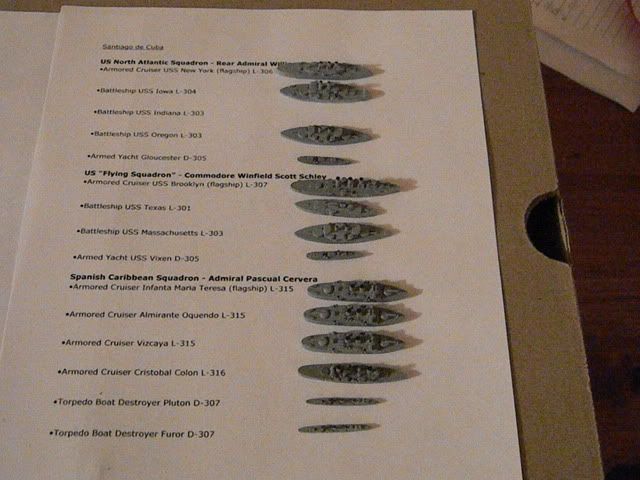
http://www.panzerschiffe.com/Catalog.html
The picture at the right shows the models before they were painted. I have used Panzerschiffe for just about all my Pre-dread fleets because they are very affordable and have a decent amount of detail.
In my opinion the only thing lacking for detail in these models is the lack of masts. As a result through researching the web, time and patience I have added the masts you see in the pcitures. The process I use is fairly simple. I use various thickness of piano wire whichI purchase from the hobby store. I then drill small holes in the model at the appropriate locations and insert the guage wire I want to use making sure it is a tight fit. If it is a two part mast I then glue and upper section to the lower thicher wire. I usually paint the wire first as the glue seems to bond better for a quick hold. In order to model the crows nest I use a thin sheet of styrene. I drill an approprite size hole in the styrene and then use a standard paper hole puch center it over the drilled hole and punch it out. This is then slid over the mast an glued in place. Overall I think the masts really add alot to the collection and bring out some eye popping detail on the gaming table especially at the 1/2400 scale.
Once the models are completely painted to my satifaction I mount them on 1"x 3" metal bases that have been pre-pianted. I use metal bases as my storage trays are lines with magnetic sheets to hold them in place for safe transport. Once mounted I add the labels and some wakes for visual effect. Once complete and dry I spray all my military models with two light coats of testors dull coat to seal them and provide a protective coating.
At this time I have the complete order of battle for the above battle as well as the Battle of Manilla bay. The rules I use are Naval Thunder Rise of the Battle ship. I only had the opportunity to sail these ships once since I completed them (See "Remeber the Maine" post). What I learned when comparing the stats is that gaming the Spanish American war is a severly lopsided affair when using historical OoB. As a result when I return home I plan to add several more spanish units for more "What if" gaming action like I did in 'Remeber the Maine" on a larger scale.
Until next time.........










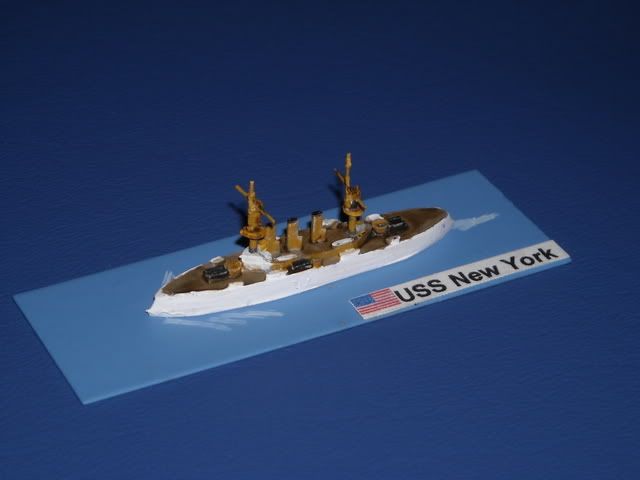

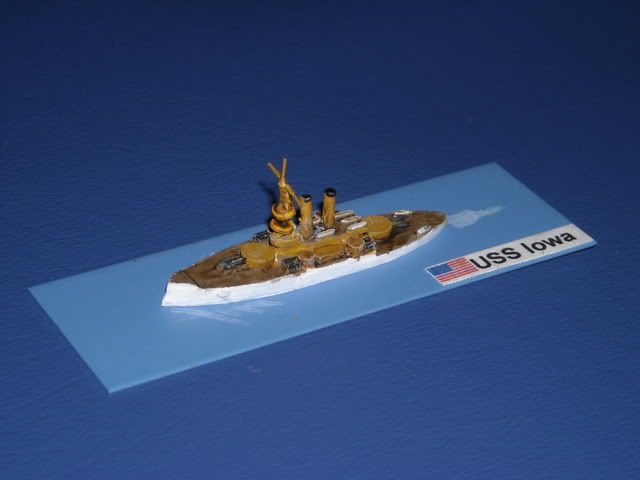
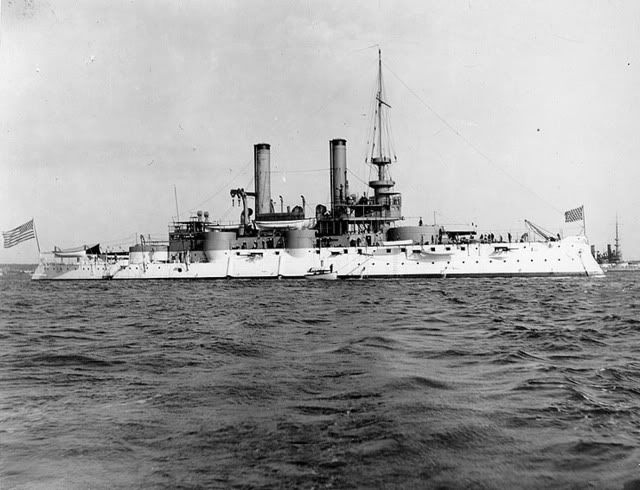
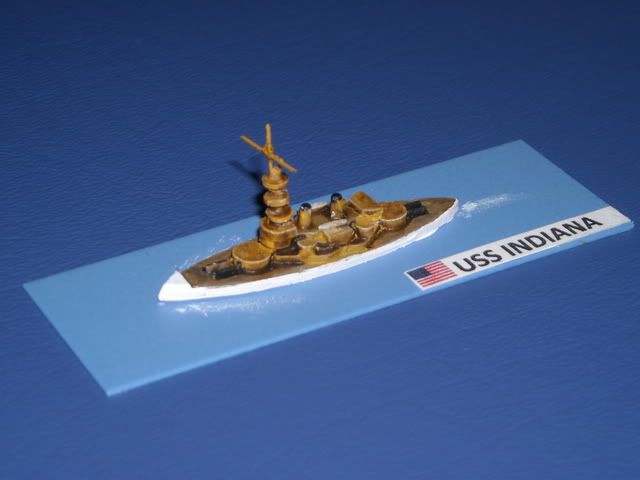


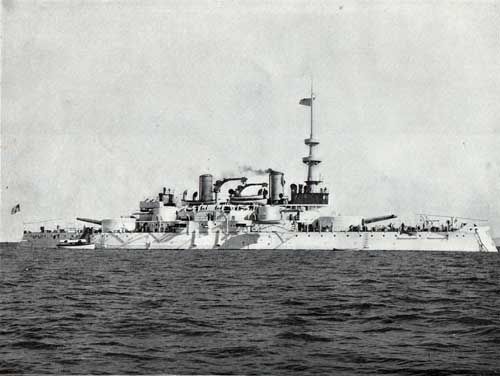

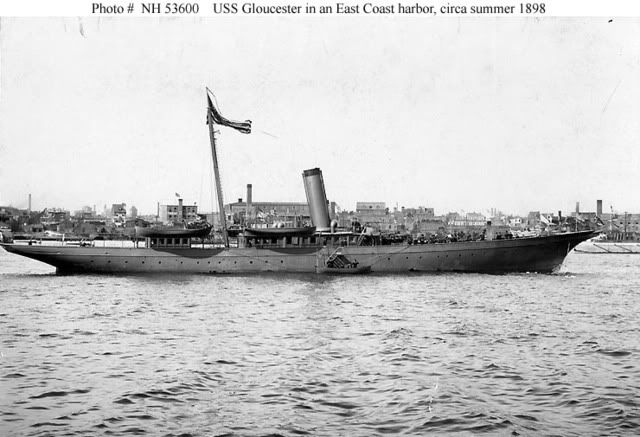
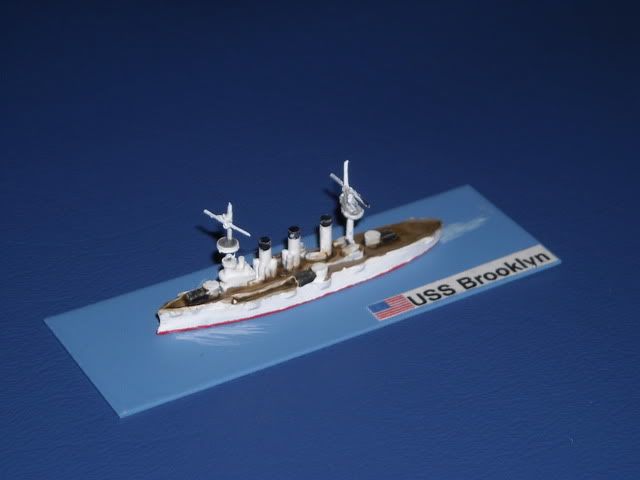

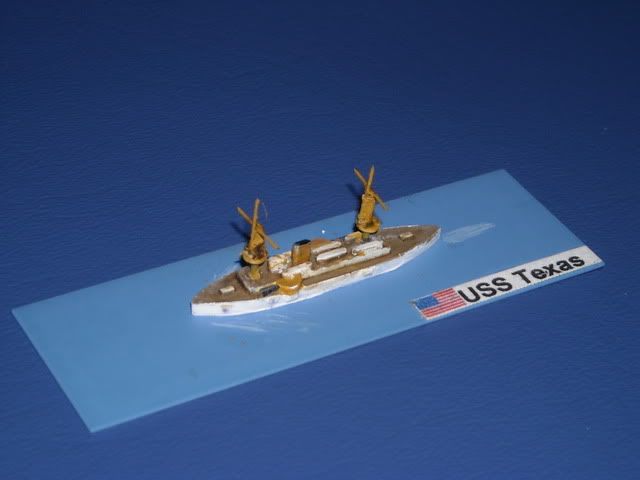

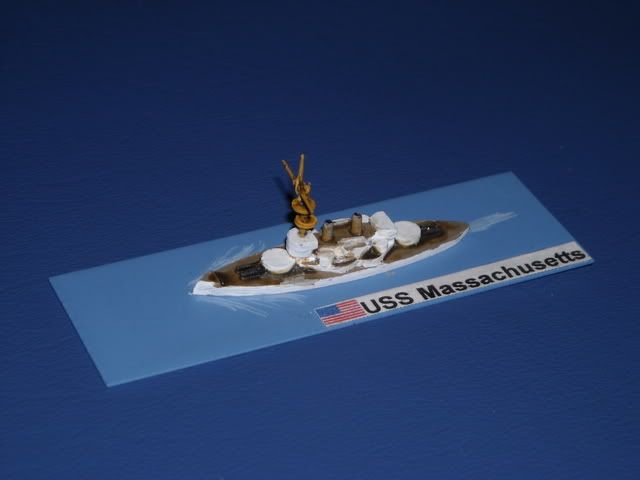

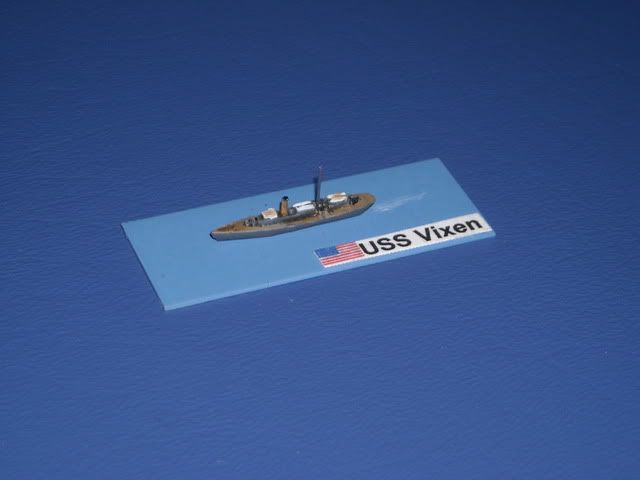



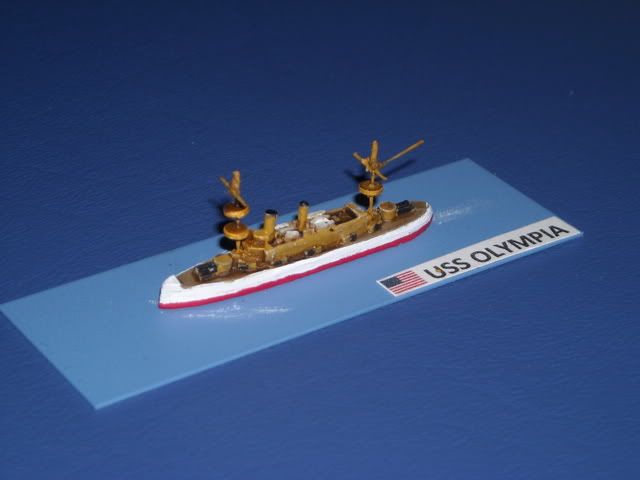
A very nice article, sir. As you know, I too like the Pre-Dreadnought period and the Panzerschiffe 1/2400 models (although I prefer the Russo-Japanese fleets).
ReplyDelete-- Jeff
Thanks Jeff, I think you are aware I have the Russo-Japanese war covered as well. They will likey be the subject of a future post. ;)
ReplyDelete